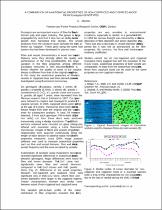 ResearchSpace
ResearchSpace
Comparison of anatomical properties of non-coppiced and coppiced wood in six Eucalyptus genotypes
JavaScript is disabled for your browser. Some features of this site may not work without it.
- ResearchSpace
- →
- Research Publications/Outputs
- →
- Conference Publications
- →
- View Item
| dc.contributor.author |
Zbonak, A

|
|
| dc.date.accessioned | 2007-07-04T12:03:52Z | |
| dc.date.available | 2007-07-04T12:03:52Z | |
| dc.date.issued | 2006 | |
| dc.identifier.citation | Zbonak, A. 2006. Comparison of anatomical properties of non-coppiced and coppiced wood in six Eucalyptus genotypes. 45th Annual Conference of the Microscopy Society of Southern Africa, Port Elizabeth, 27 November - 1 December 2006, pp 46 | en |
| dc.identifier.isbn | 9780620372947 | |
| dc.identifier.uri | http://hdl.handle.net/10204/971 | |
| dc.description.abstract | Eucalypts are an important source of fibre for the South African pulp and paper industry. The genus is largely propagated by seed but it also has an ability to resume growth from harvested tree stumps. The shoots produced from the cambium layer beneath the bark are known as “coppice”. These grow using the same root system that had been developed for planted trees. Fibre and vessel characteristics in wood are important features since they strongly affect the quality and performance of the final product. While the large variation in the fibre properties among different Eucalyptus resources is well documented, little is known whether the quality of wood of the coppice shoots is different from that of the original seedling tree. In this study the anatomical properties of fibres and vessels in coppiced trees and their planted parents were investigated using fluorescent microscopy. | en |
| dc.language.iso | en | en |
| dc.subject | Mavuya research trial | en |
| dc.subject | Anatomical properties | en |
| dc.subject | Fibre characteristics | en |
| dc.subject | Vessel characteristics | en |
| dc.title | Comparison of anatomical properties of non-coppiced and coppiced wood in six Eucalyptus genotypes | en |
| dc.type | Conference Presentation | en |
| dc.identifier.apacitation | Zbonak, A. (2006). Comparison of anatomical properties of non-coppiced and coppiced wood in six Eucalyptus genotypes. http://hdl.handle.net/10204/971 | en_ZA |
| dc.identifier.chicagocitation | Zbonak, A. "Comparison of anatomical properties of non-coppiced and coppiced wood in six Eucalyptus genotypes." (2006): http://hdl.handle.net/10204/971 | en_ZA |
| dc.identifier.vancouvercitation | Zbonak A, Comparison of anatomical properties of non-coppiced and coppiced wood in six Eucalyptus genotypes; 2006. http://hdl.handle.net/10204/971 . | en_ZA |
| dc.identifier.ris | TY - Conference Presentation AU - Zbonak, A AB - Eucalypts are an important source of fibre for the South African pulp and paper industry. The genus is largely propagated by seed but it also has an ability to resume growth from harvested tree stumps. The shoots produced from the cambium layer beneath the bark are known as “coppice”. These grow using the same root system that had been developed for planted trees. Fibre and vessel characteristics in wood are important features since they strongly affect the quality and performance of the final product. While the large variation in the fibre properties among different Eucalyptus resources is well documented, little is known whether the quality of wood of the coppice shoots is different from that of the original seedling tree. In this study the anatomical properties of fibres and vessels in coppiced trees and their planted parents were investigated using fluorescent microscopy. DA - 2006 DB - ResearchSpace DP - CSIR KW - Mavuya research trial KW - Anatomical properties KW - Fibre characteristics KW - Vessel characteristics LK - https://researchspace.csir.co.za PY - 2006 SM - 9780620372947 T1 - Comparison of anatomical properties of non-coppiced and coppiced wood in six Eucalyptus genotypes TI - Comparison of anatomical properties of non-coppiced and coppiced wood in six Eucalyptus genotypes UR - http://hdl.handle.net/10204/971 ER - | en_ZA |





